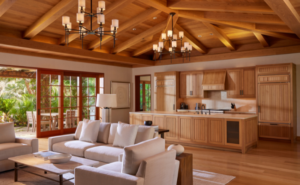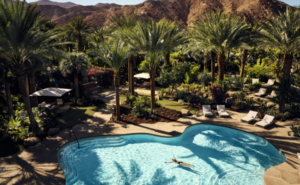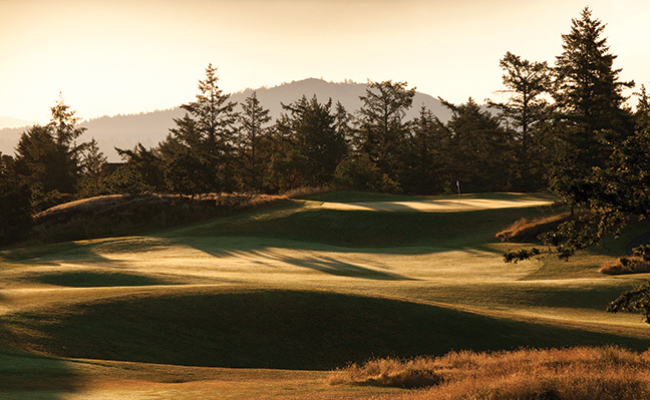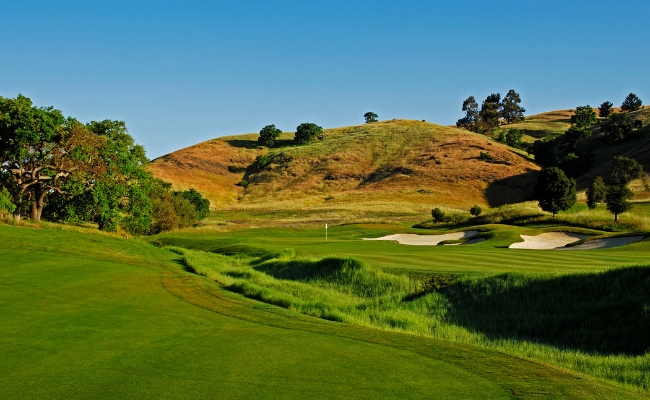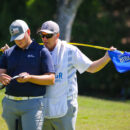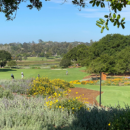New Age Golf: At Sensei Porcupine Creek, Personal Growth Outweighs Score

For golfers, one of the world’s white whale courses has breached; for players seeking to experience an immersive coalescence of wedge and wellness, an entire ocean of possibility has emerged in the SoCal desert.
Carved into 230 acres of prime Rancho Mirage terrain and framed by the Santa Rosa Mountains, Sensei Porcupine Creek has been cloaked in mystique since the property — including its modern classic golf course — debuted as a private estate in 2004, sans the Sensei preface. In 2011, the grounds were bought by Oracle co-founder Larry Ellison, whose local footprint was precluded the year before when he purchased the nearby Indian Wells Tennis Garden and the annual BNP Paribas Open.
Last November, however, the lore was opened for exploration. Sensei Porcupine Creek can now be experienced as an opulent, 22-room boutique wellness retreat. Founded by Ellison and reputed physician/best-selling author Dr. David Agus, the Sensei brand isn’t so much an itinerary or recipe as it is an individually curated journey of well-being. Based on an ethos of “Move, Nourish and Rest,” the path leads guests along a studied engagement of mind and body.
An Accessible Challenge
“For the folks who have been tracking us, the urge to play is there,” says Richard Ruddy, director of golf at Sensei Porcupine Creek.
Designed by original property owner Tim Blixseth — with reported help from the likes of Dave Stockton, Annika Sörenstam and Tom Weiskopf — Porcupine, even amid a dearth of estate play, was ranked by one leading outside source as the 13th best course in the entire state. Originally conceived as a migration through playing ecosystems, the course was only seen by most from an interloping view from above via the public-access Bump-n-Grind hiking trail.
Since Ellison — ranked by Forbes as the world’s fourth-wealthiest person — purchased the property, the grounds have enjoyed extensive renovation. Round counts, however, remained low, with the likes of President Barack Obama and 22 time Grand Slam tennis champion Rafael Nadal on the short list of golf guests.
“There were no members who could invite members,” says Ruddy. “One person held the key.”
Ruddy, who came from Sandpiper GC in Santa Barbara to run Sensei’s golf program, has a deep familiarity with the grounds, having often served as golf host and playing partner to estate guests.
“A lot changed once it got ‘Ellison-ized,’ I guess you could say,” Ruddy continues. “Through a collaboration of people around him — friends, colleagues, golfers … not one big design name has their stamp on it — the course was made more youthful and fun with different bunkering, different tee boxes, different greens. I’ve seen the course become much more dynamic over the years.”
Upon announcement of the transition from estate to retreat, Ruddy and the Porcupine golf staff were pleased to maintain a tenor of exclusivity.
“It’s never going to be a circus around here; it’s always going to have that personal and private feel for the guests,” Ruddy says. “We’re not trying to be a golf resort or a golf school. We’re a wellness retreat with a world-class golf course.”
“You come here, you can play by yourself if you like, and you may not see anybody else the entire round,” says Barrett Damerel, assistant golf professional. “We want guests to come out and feel no pressure, to not worry about somebody behind them or about keeping pace with the group ahead.”
From a manicuring standpoint, the conditions require but a single word: Unmatched. The nearly 6,700-yard card glides with nary a blade out of place, framed by a gorgeous symphony of peripheral fairway flora. The conditions are so pristine that a player would be forgiven for feeling guilt when knocking sand off spikes onto immaculate grass post-bunker shot.
“Our top goal is to present the best conditions possible, and we basically work with a ‘no excuse’ standard,” Nelson says. “We’re checking everything, tiny details, things that often get lost on golf courses that have more budget restrictions and more volume of play.”
The front nine at Sensei Porcupine Creek is laid out like a Zen garden. Color splashes abound, mixed with an introduction to 15 different species of palm trees (there are more than 2,500 palms on the property). Offering a resort-style narrative and sporting forgiveness for high-handicap guests, the landing areas are generally spacious across the opening side and matched with bowled fairway edges to bound crooked shots back into play.
“The course has been built so that the holes kind of sink into the landscaping,” describes Ruddy. “You can really get into your own little world.”
As the round evolves, the harmony extends in kind. Boulders imported from Sedona, Ariz., extend the aesthetic and are offset by popping bougainvillea, bright yellow Tecoma stans and, eventually, the rare desert sight of bamboo.
Turning to the latter nine, the Sensei experience grows in test, appearance and elevation.
Full engagement begins with a shot-making 280-yard uphill dogleg-right on the par-4 11th, before a more earnest test is found on Sensei’s longest hole, the 559-yard, uphill par-5 13th.
Following an elevated, palette-style putting surface on the par-4 14th, Sensei awes in full with a 250-foot Santa Rosa climb to the par-3 15th which, much like the dramatic ascent and rocky chasm, features a multi-tiered green that is certain to give pause to players of all levels.
Rounding home, the lush look of the course reappears at the No. 1 handicap 16th hole, where golfers are faced with a forced carry from a 200-foot-high tee box over desert, lake and a massive, mid-fairway bunker. At 484 yards, the muscular par-4 17th offers little relief, before the par-5 home hole tests a player’s shot-making skills with six strategically placed bunkers.
For the motivated golf guest, the layout can be enjoyed again and again. The course is yours.
Optimal Experience
While guests can experience the property as a resort-style getaway complete with pool time, spa treatments and the all day/night flavors of Sensei by Nobu, visitors seeking well-being expertise can choose from an individualized menu of one on-one sessions in yoga, fitness, nutrition, meditation, mindfulness, targeted massage and more.
A state-of-the-art golf Optimal Wellbeing Program (OWP) at Sensei combines a full lineup of science-based sessions over a five-night stay while still allowing ample time for a personalized golf pro and, yes, unlimited rounds.
“The program can be session-heavy, but we’re not telling people what they have to do,” says Ruddy. “Some guests just want to come out and play a ton of golf. The sessions are fluid. We‘re happy to shift things around.”
Golf OWP guests are provided with a WHOOP 4.0 wristband device that allows them to chart their baseline heart rate, sleep and strain data. Upon arrival, staff then conducts introductory intention and wellbeing evaluations, ranging from blood pressure, body composition, gait observation, VO2 Max analysis and grip pressure.
With information and a game plan assembled, the visitor can then begin a flexible golf odyssey that can take the mind where the body may follow.
Such experiences define Sensei Porcupine Creek as a golf destination like no other.
“This program is built so that we can have space and time with the guests, and to be able to experience growth,” explains Tegan Reeves, mindset guide at Sensei Porcupine Creek. “The kind of growth that we really want people to experience requires a walk around the property. That may come, for example, in the form of having a mindset session and then seeing you breathe in your pre-shot routine.”
A greater understanding of breathing and controlled heart rate variability can impact neural pathways and, ultimately, enhance performance. Much like working on a swing, mental study requires prep time and working with techniques such as gratitude practice.
“The idea is that if you practice building this mindscape for 10 minutes a day, it can change your physiology,” explains Reeves. “Whether it’s feeling the sand on your toes, the wind on your face, whatever it may be, it can become so vivid that in a moment where you’re feeling stress you can recall one piece of that gratitude and your physiology will automatically go there.”
Whether sessions take place in a pavilion setting or while practicing 12-footers, the Sensei way of exploring mindfulness may well prove to be a more impactful tool than any club, shoe, ball or swing aid.
Where else can a player stand atop an elevated tee box for an hour just to experience a meditational intervention?
“If we can send practitioners — yoga, fitness, meditation — out on the course with our guests to see what it is they’re passionate about doing or achieving, we can apply techniques anywhere,” says Per Erez, a meditation practitioner at Sensei Porcupine Creek.
For the free-thinking player, studying the connection between the body and the breath and the body and the earth can eliminate the residue of traditional swing thinking. In a very Sensei way, try to imagine this gentle voice in the ear before a tee shot.
“The land moves, and we move,” Erez concludes. “There’s a kind of sympathetic resonance that we’re looking for. As you swing the club, there’s an arc; there’s an arc to the ball’s movement; there’s an arc to the flow of the fairway and the green. And as you think about coherence, all of these things align, with a beginning, a middle and an end.”



